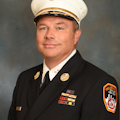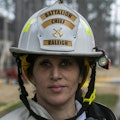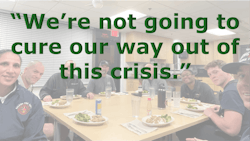Suicide Prevention by Design: Engineering Better Solutions to Save Firefighters' Lives
On Nov. 16, 2024, Chief John McMahon, a well-known advocate for mental health, died by suicide, sending shockwaves through the first responder community. McMahon dedicated his life to serving others through his work with Memorial Weekend, the Florida Firefighter’s Memorial, Guns and Hoses Pipes and Drums, and his unwavering commitment to peer support and suicide prevention. He dedicated his life to serving others and making the fire service stronger.
His death is a heartbreaking reminder that suicide can touch anyone, even those who seem the strongest among us. It’s a tragedy that calls for more than words. It calls for change.
After McMahon’s passing, familiar messages started circulating:
- “Know the warning signs.”
- “It’s okay not to be okay.”
- “Reach out for help.”
- “Combat the stigma.”
These messages are well-meaning but also beg the question: Are awareness, education, and detection alone enough?
The truth is that despite years of efforts to reduce stigma and expand mental health resources, suicide rates continue to rise. Every year, more people die by suicide than the year before. Sadly, there is no effective algorithm to predict suicide.
To make real progress in suicide prevention, we must shift from traditional, reactive approaches to a proactive, systems-oriented perspective. Current models often focus on individual interventions after warning signs emerge, but they overlook the broader systems that shape mental health outcomes. In many areas of life, design plays a crucial role in creating better experiences and outcomes—whether through technology, urban planning, or public health initiatives. Similarly, suicide prevention must consider how environments, processes, and resources can be engineered to support mental well-being.
It is about identifying the upstream causes of mental health crises and redesigning and engineering systems that prioritize prevention and resilience. This involves moving upstream to reduce the risk before it happens.
Suicide isn’t caused by one thing—it’s the result of many complex factors coming together. That’s why solutions must be just as multi-layered.
Ali’s experience
I know how difficult these conversations can be because I’ve lived through my own struggles with suicidal thoughts. They aren’t something that just disappeared after I sought help. They ebb and flow, returning during times of intense stress. Over the years, I’ve learned how to manage them, but they never entirely go away.
I also recognize how easy these thoughts are to hide from others. I’ve had moments where I was struggling deeply, yet no one around me had any idea. That’s the thing about suicidal thoughts—they can be invisible to others, even to those closest to you.
What helped me most wasn’t just awareness or stigma-reduction campaigns—it was practical, actionable strategies that gave me time and space to work through those dark moments.
That’s why I’m passionate about rethinking how we approach suicide prevention. It’s not enough to wait for warning signs or hope someone reaches out when they are in crisis. We need systems and tools that create safety and space for recovery before the crisis hits.
Rethinking suicide prevention
Most efforts now focus on recognizing warning signs and identifying those at risk. But this approach has limits:
- Many who die by suicide show few clear warning signs.
- Most people with risk factors never attempt suicide.
- Suicidal crises can happen suddenly, leaving little time for intervention.
As psychiatrist Dr. Eric Caine says: “We’re not going to cure our way out of this crisis.”
Instead of focusing on individuals at risk, we need to prevent suicide by designing systems and environments that reduce risk before it happens. It’s like how engineers improved traffic safety. They didn’t just tell drivers to slow down—they built roundabouts, added guardrails, and changed road designs to make driving safer overall.
We can take the same approach to suicide prevention by focusing on three practical strategies: preplanning crisis, understanding tipping points, and creating barriers to lethal means.
A three-pronged approach
1. Preplanning with a Crisis Card
When someone is in crisis, they may not think clearly. That’s why planning ahead of time can make all the difference. A crisis card is a simple tool anyone can create to guide themselves—or someone they love—through intense moments.
This is something everyone—not just those “at risk”—should create. Why? First, you might encourage others to do the same by making your own.
Here’s what to include:
- Three Trusted Contacts: People you can call for support—friends, family, or colleagues who will listen without judgment.
- Three Coping Activities: Things you enjoy or find relaxing, like walking, reading, dancing, crafts, or journaling.
- One Mood-Calming Technique: For example, box breathing: inhale for 4 seconds, hold for 4, exhale for 4, and hold again for 4. This can help calm your mind in just a few minutes. (Many other mood-calming techniques can be learned and practiced ahead of the crisis.)
- The 988 Suicide & Crisis Lifeline: Counselors on the other end are trained to recognize the need to simply move an individual out of a high-risk state by creating hope.
Keep your crisis card somewhere easy to find—on your phone, in your wallet, or even posted at home. Even if it’s not always accessible, creating the card will develop a mental model that can be activated when a crisis strikes.
2. Understanding the Tipping Point
Suicide isn’t a constant risk—it ebbs and flows, often influenced by little things. A tipping point is when someone moves closer to acting on their pain or pulls back toward safety.
The challenge is that we don’t always know when someone is near their tipping point. Suicidal thoughts are more common than many realize, and those who’ve experienced them may hide their struggles well.
That’s why small, positive actions matter so much. A kind word, a thoughtful gesture, or simply showing someone they’re not alone can push them toward hope. On the flip side, negativity or indifference can make things worse, especially for someone already struggling.
You don’t need to be a leader to show kindness. However, leaders who express genuine appreciation for their team through small, positive actions help foster unity, build trust, and create the cohesion necessary for success. Sometimes, a kind word, a thoughtful gesture, or simply showing someone they’re not alone can make a world of difference.
The best leaders have a remarkable ability to make others feel seen and valued. Their influence often extends beyond what they realize—sometimes making an impact so profound, it can save lives without them even knowing it.
Think about the leaders who have influenced you or those who have shaped your own leadership style. These individuals likely possess these qualities, demonstrating that kindness and empathy are core leadership attributes. These are the leaders I (Leeb) emulated when I was developing my leadership style. These individuals embody “soft skills” that are invaluable in building trust, fostering connection, and supporting others, particularly when it comes to the mental well-being of their teams.
The takeaway? Be kind. Always. You never know when a small act might save a life.
3. Barriers to Lethal Means Access
Firearms are involved in 65 percent of suicides among first responders. That’s why reducing immediate access to guns during high-stress times could be the single most effective way to save lives.
This isn’t about taking guns away—it’s about creating time and space.
The data speaks for itself:
- 75 percent of first responders own a handgun, but less than half store them safely.
- Having a loaded gun in the house makes suicide 4-6 times more likely.
- Many people transition from suicidal thoughts to action in less than 10 minutes.
I’ll never forget a podcast I listened to where a soldier shared that simply placing his handgun in a safe significantly reduced his suicidal thoughts. He hadn’t realized how the constant presence of the weapon contributed to his consistent thoughts of suicide until it was out of sight.
Here’s how to ensure time and space during a crisis: If you are going through a loss or experiencing depression, thoughts of suicide, or bouts of anxiety,
- Store firearms in a safe or lockbox.
- Keep ammunition separate from guns.
- Ask a trusted friend, family member, or gun shop to hold onto your firearms temporarily.
- Place your crisis card above your weapon to create a moment of pause.
The goal isn’t restriction but rather time to let the crisis pass and the mind regain balance.
Pushing toward hope
McMahon’s passing reminds us that we have more work to do. Suicide prevention isn’t just about raising awareness. It’s about action. By pre-planning with crisis cards, understanding tipping points, and creating barriers to firearms, we can build systems that protect lives.
We’ll never know how much a kind word, a simple plan, or a moment of pause can mean to someone on the brink. But we do know this: these small actions add up. They save lives.
In honor of McMahon and all those we’ve lost, let’s commit to doing more—building systems of hope and protection for those who serve and for ourselves.
About the Author

Frank Leeb
Frank Leeb is the managing director of the First Responder Center for Excellence. He previously served as a deputy assistant chief in FDNY, retiring in June 2024 after more than 31 years. During his tenure with FDNY, Leeb held several senior staff positions, including chief of the fire academy, chief of training and chief of safety. He also has been a member of the East Farmingdale, NY, Volunteer Fire Department since 1983. Leeb holds a bachelor's degree in fire service administration from SUNY Empire State and a master’s degree in security studies from the Naval Postgraduate School, Center for Homeland Defense and Security. He served as an advisory panel member for UL's Fire Safety Research Institute's "Study of Coordinated Fire Attack Utilizing Acquired Structures" and was the keynote speaker for Firehouse Expo in 2022 and FireFusion 2024. Leeb is the author of "Cornerstones of Leadership: On and Off the Fireground." He was a presenter at the 2022 and 2023 U.S. Fire Administrator Summit on Fire Prevention and Control. Leeb can be contacted at [email protected].

Dena Ali
Dena Ali is a battalion chief with the Raleigh, NC, Fire Department. She also serves as the program manager of behavioral health for the First Responder Center for Excellence. Ali holds a degree from North Carolina State University and an MPA from the University of North Carolina—Pembroke, where her research focused on firefighter suicide. She is an Executive Fire Officer Program graduate through the National Fire Academy. Throughout her career, she has received several awards, one of the most notable being the North Carolina Office of State Fire Marshal Honor, Courage, and Valor Award her steadfast efforts to bring awareness to firefighter mental health through her vulnerability. Ali is the author of the book Hope out of Darkness: A Guide to First Responder Mental Wellness.
